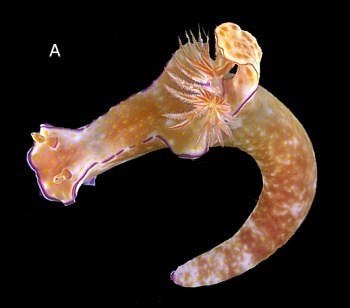
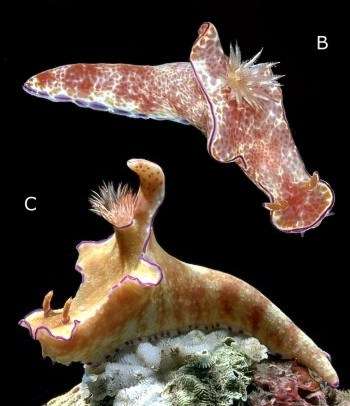
Ceratosoma trilobatum
(J. E. Gray, 1827)
Order: NUDIBRANCHIA
Suborder: DORIDINA
Superfamily: EUDORIDOIDEA
Family: Chromodorididae
DISTRIBUTION
Tropical Indo-West Pacific.
PHOTO
A, Île aux Canards, Nouméa, New Caledonia, 19m, 20 October 1988. B, Chenal de la Passe de Koumac, New Caledonia, 66m, in lagoon, mud, shell-sand, October 1993, 47mm long alive.
C, Pointe de Pandop, Koumac, New Caledonia, 2 m, hard substrate, 18 October 1993, 120mm long alive.
PHOTOS: Bill Rudman.
Widespread Indo-West Pacific species often confused with Ceratosoma tenue. It is characterised by having only one large lateral lobe on each side of the body, just anterior to the gills. There is usually a ridge joining each lateral lobe to the anterior head lobe. The background colour can vary from pale green to orange-red or brown, usually, but not always, mottled and spotted with lighter colours. There are usually small yellow or orange spots and the edge of the mantle, and sometimes the foot, is bordered with a broken or continuous purple line.
See separate page for colour variants in northwestern Australia.
Most species of Ceratosoma have a long recurved dorsal 'horn' which acts as a defensive lure attracting potential predators to the part of the animal which contains most of the distasteful chemicals stored from their food. See Mark Levin's photo. See also Ceratosoma brevicaudatum for photos of that species' conspicuously marked 'tail', especially in juveniles. This colour 'target' probably also attracts potential predators to the most distasteful part of the animal (Rudman, 1991). See photo of Ceratosoma tenue from Dar es Salaam, in which whole dorsal horn has been cut off, probably bitten off.
References:
•Rudman, W.B. (1984) The Chromodorididae (Opisthobranchia: Mollusca) of the Indo-West Pacific: a review of the genera. Zoological Journal of the Linnean Society 81: 115-273.
•Rudman, W.B. (1988b) The Chromodorididae (Opisthobranchia: Mollusca) of the Indo-West Pacific: the genus Ceratosoma J.E. Gray. Zoological Journal of the Linnean Society, 93(2): 133-185.
• Rudman, W.B. (1991) Purpose in Pattern: The evolution of colour in chromodorid nudibranchs. Journal of Molluscan Studies, 57 (T.E.Thompson Memorial Issue): 5-21.
Rudman, W.B., 1999 (September 29) Ceratosoma trilobatum (J. E. Gray, 1827). [In] Sea Slug Forum. Australian Museum, Sydney. Available from http://www.seaslugforum.net/find/ceratril
Related messages
Re: Juvenile of Ceratosoma bicolor from Lembeh?
October 28, 2009
From: Zeineb Alhaidari
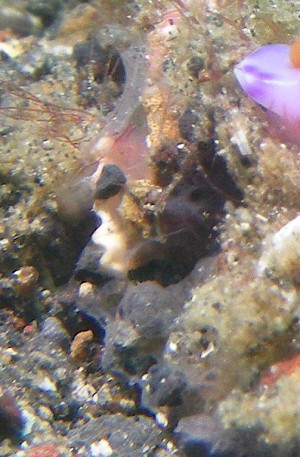
Concerning message #22720:
Dear Bill,
I don't know if this is going to help , but here it is. Again many thanks for all the information we get on your forum.
Kind regards,
Zeineb Alhaidari
z.alhaidari@wanadoo.fr
Alhaidari, Z., 2009 (Oct 28) Re: Juvenile of Ceratosoma bicolor from Lembeh?. [Message in] Sea Slug Forum. Australian Museum, Sydney. Available from http://www.seaslugforum.net/find/22731Dear Zeineb,
Thanks very much. I suspect it is a dysideid sponge, which this genus feeds on, as there seem to be a network of fibres. However I am afraid I can't see enough detail to be sure. Better luck next time.
Best wishes,
Bill Rudman
Juvenile of Ceratosoma bicolor from Lembeh?
October 27, 2009
From: Zeineb Alhaidari
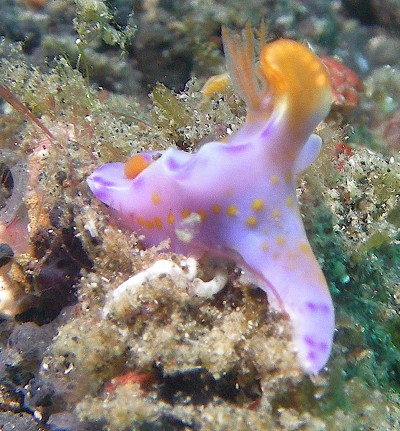
Concerning message #5061:
Dear Bill,
I am unable to identify this little Ceratosoma observed during a dive on Critter Hunt , Lembeh , Sulawesi . Due to its small size , I guess it could be a juvenile , and may be due to the bright orange rhinophores and dorsal horn , could it be Ceratosoma bicolor?
Locality: Dive Site : Critter Hunt , Lembeh Strait, 16 metres, North Sulawesi , Indonesia, Molucca sea, 8 october 2009, Sandy bottom with scattered reefs. Length: 1 cm. Photographer: Zeineb Alhaidari.
Many thanks for your help,
Zeineb
z.alhaidari@wanadoo.fr
Alhaidari , Z., 2009 (Oct 27) Juvenile of Ceratosoma bicolor from Lembeh?. [Message in] Sea Slug Forum. Australian Museum, Sydney. Available from http://www.seaslugforum.net/find/22720Dear Zeineb,
Juvenile specimens of Ceratosoma never fail to amaze me. Why should such a defenceless juvenile want to flaunt itself with such bright colours - even to having an uproght dorsal horn of a different colour almost advertising to fish that here is a tasty item to eat. But if you look carefully you can see the small whitish spheres packed in a row along the edge of the dorsal horn. These spheres are packed full of distasteful poisons the nudibranch has accumulated from its sponge food and it seems there sole purpose is to defend the nudibranch from attack. So what at first looks like an accident waiting to happen is a cunning lure enticing potential prey to take a bite and learn a salutary lesson.
Now to the question of what species it is. As I have said elsewhere, I think we have to learn a bit more about C. bicolor before we can be sure it is a good species and not just a colour form of C. trilobatum. My feeling is that most species of Ceratosoma cannot be distinguished by their colour pattern, most species having a similar range of colour variations. It seems to me that species of Ceratosoma are best distinguished by the shape of their bodies. For example your animal has 1 dorsal lobe and 1 lateral mantle lobe on each side [= 3 lobes] which makes it C. trilobatum [tri = 3; lobatum = lobes].
Concerning its food sponge. I suspect it may be the blue-grey material on the left of your photo. If by chnace you have a photo which shows the sponge more clearly I would love to see it. I suspect at this magnification that if the sponge is in focus the nudibranch wont be.
Best wishes,
Bill Rudman
Re: Ceratosoma trilobatum from Bali
October 13, 2008
From: Marcel Tanke
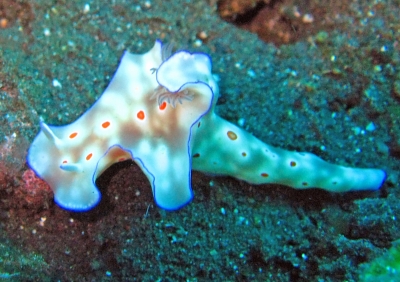
Concerning message #20620:
Hi Bill,
I can't resist sending you this beauty that we found about 80 meters west of the Liberty Wreck, see previous message. My wife Marion found it at 21 m depth. As it was close to a some rock and hard to take a photogragh, I picked it up for the pictures attached. It feld very light and strong, like thin porcelain. The next 3 days we went back 4 times to exactly the same spot, and surroundings, but couldn't find it a second time.
Locality: Coral Bay, Tulamben, 21 m, Bali, Indonesia, 1 October 2008, black sand. Length: 9 cm. Photographer: Marcel Tanke.
Best regards,
Marcel
marceltanke@cs.com
Tanke, M.A., 2008 (Oct 13) Re: Ceratosoma trilobatum from Bali. [Message in] Sea Slug Forum. Australian Museum, Sydney. Available from http://www.seaslugforum.net/find/21953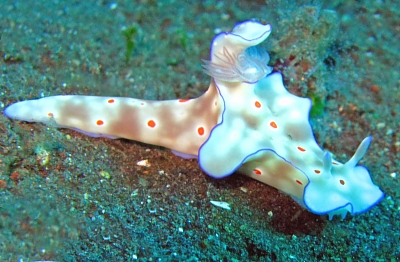
Dear Marcel,
It's certainly interesting to get an almost identical colour pattern from almost the same spot as in the previous message. However we also have photos from the Philippines and southern Queensland of similarly coloured animals so we can't say it is confined to a certain geographical area. If these animals were any other chromodorid genera, I would consider the different colour forms to indicate different species, but from all the anatomical evidence, and intermediate colour forms, body shape, not colour, is the species indicator in Ceratosoma.
Best wishes,
Bill Rudman
Ceratosoma trilobatum from Mussandam, Oman
July 23, 2008
From: Yahia Mokhtar
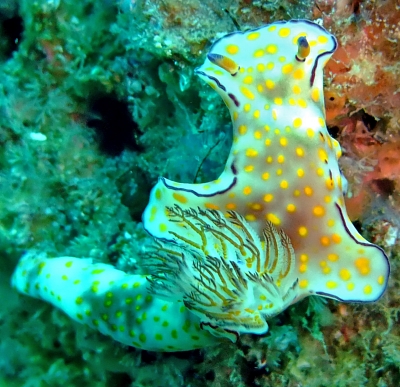
Concerning message #21625:
I think this is another "Risbecia pulchella " despite the weird "H" shape.
Locality: Ras Dillah, 15-20 m, Mussandam, Oman, Arabian Gulf / Indian Ocean, 13 June 2008, Rocks. Length: 5-6 cm. Photographer: Yahia Mokhtar.
Yahia
yahia@adma.ae
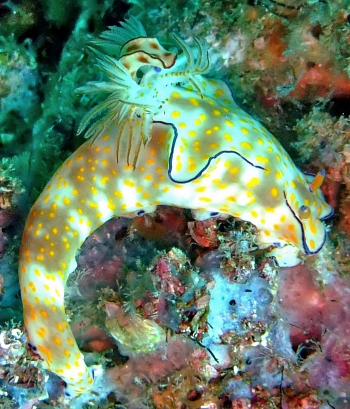
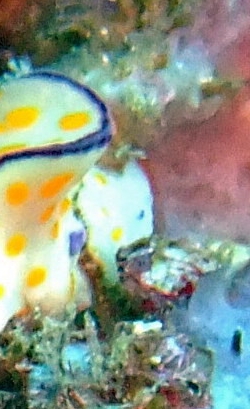
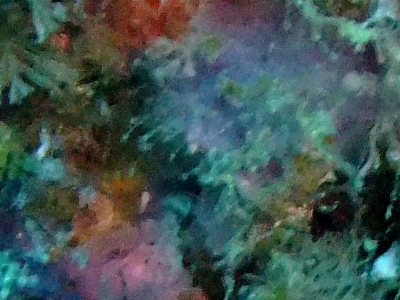
Dear Yahia,
The yellow spots certainly suggest R. pulchella and its yellow-spotted 'friends', but its shape means it must be a species of Ceratosoma. Unlike most other chromodorids, colour is not a good character for identifying species of Ceratosoma, but fortunately, their external shape is consistent. This is Ceratosoma trilobatum.
Of great interest is that your photos show this animal feeding on the bluish sponge colony. I have included a close-up alongside your middle photo which shows the oral tube extended out into the sponge. It's not perfectly in focus but it is clear enough to confirm what is happening. The sponge colony is partly overgrown by algae and the bits that we can see looks as though they are the remains of a large colony which has been almost completely eaten by the Ceratosoma. Although I can't see detail in the sponge structure, I think I have seen enough 'remains' like this to be confident that this is a dysideid sponge, perhaps a species of Euryspongia. This is the first direct evidence we have of the food of this species. At present all we have is indirect evidence from chemists [Mollo et al, 2005] who have found molecules characteristic of dysideid sponges in the mantle glands of C. trilobatum.
-
Mollo, E., Gavagnin, M., Carbone, M., Guo, Y.-W., and Cimino, G. (2005) Chemical studies on Indopacific Ceratosoma nudibranchs illuminate the protective role of the dorsal horn. Chemoecology 15: 31-36.
Best wishes,
Bill Rudman
Ceratosoma trilobatum from Egypt
June 10, 2008
From: Dorota Czerny
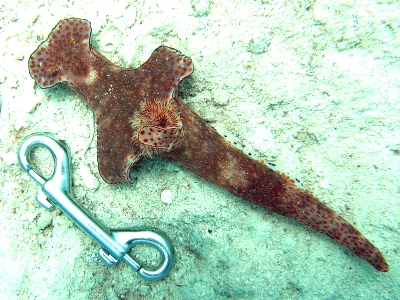
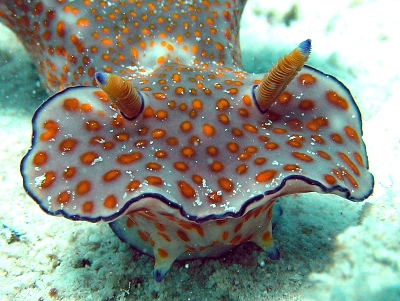
Concerning message #21623:
Hello everyone. I am new to the Forum, thou I have used the information on the site before.
But..today we have spotted a very unusual nudibranch. I believe it is Ceratosoma tenue. But it was very huge - about 18 - 20 cm! We are wandering if that can be connected with the age of the animal or thay can grow up to this size? Very very rare animal here.
Locality: Hurghada, 10m, Egypt, Red Sea, 9 June 2008, sandy bottom close to reef. Length: 18 - 20 cm. Photographer: Alicja Polaczek.
Sunny regards,
Dorota
dorota@divetrek.com.pl
Czerny, D.I., 2008 (Jun 10) Ceratosoma trilobatum from Egypt. [Message in] Sea Slug Forum. Australian Museum, Sydney. Available from http://www.seaslugforum.net/find/21639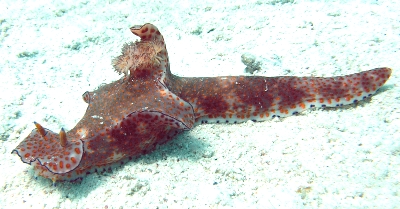
Dear Dorota,
This is certainly a species of Ceratosoma, but is C. trilobatum. As you have noticed, the shape of these animals seems very strange, especially if you haven't seen one before.
Best wishes,
Bill Rudman
Ceratosoma trilobatum from Ningaloo Reef, WA
February 7, 2008
From: Kristin J Anderson
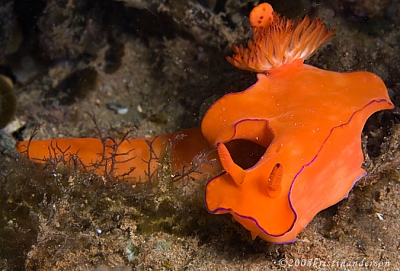
Dear Bill
Found this brilliant orange Ceratosoma over the weekend.
Locality: Exmouth Gulf, 6 m, Western Australia, Exmouth Gulf, 03 February 2008, muddy, silty bottom, found crawling through the "weeds". Length: 7 cms. Photographer: Kristin Anderson.
Kristin Anderson
kristin@oceansbyanderson.com
Anderson, K.J., 2008 (Feb 7) Ceratosoma trilobatum from Ningaloo Reef, WA. [Message in] Sea Slug Forum. Australian Museum, Sydney. Available from http://www.seaslugforum.net/find/21360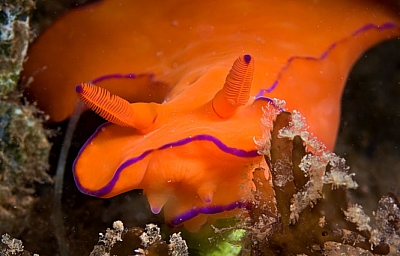
Dear Kristin,
This is Ceratosoma trilobatum. The taxonomy of this genus used to be quite chaotic because quite sensibly we tried to separate species out on the basis of their colour patterns, just as we do in most other genera of the Chromodorididae. However it seems that in Ceratosoma the external shape of the body and not the colour is the way to separate species. In C. trilobatum animals have a distinct ridge around the mantle edge and there is only one lateral lobe on each side. Colour is extremely variable and often almost identical to that of species of C. tenue and C. gracillimum. This bright almost uniform orange red colour form appears quite common in northern and northwestern Australia - sometimes with a purple border and sometimes without. Have a look at the page with photos of animals from Darwin in northern Australia
Best wishes,
Bill Rudman
Ceratosoma trilobatum from Bali
September 5, 2007
From: Kenneth Yong
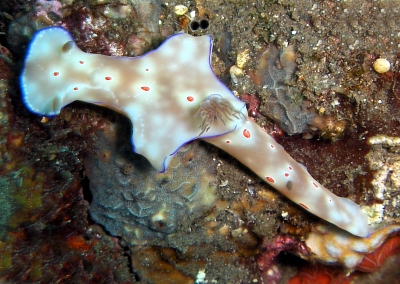
Dear Bill,
Is this Ceratosoma trilobatum? Photographed on the wreck of the Liberty, off Tulamben in Bali, it was in movement, crawling along pretty quickly.
Locality: Tulamben, the Liberty Wreck, 12 m, Bali, Indonesia, Java Sea, 28 July 2007. Length: 6-7 cm. Photographer: Kenneth Yong.
Thanks very much,
Kenneth
kyong67@tiscali.it
Yong, K., 2007 (Sep 5) Ceratosoma trilobatum from Bali. [Message in] Sea Slug Forum. Australian Museum, Sydney. Available from http://www.seaslugforum.net/find/20620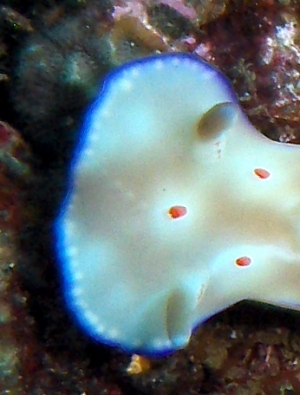
Dear Kenneth,
Yes I would call this C. trilobatum. It is possible this reddish spotted form is a link to the animals from the Japanese region which have been given a separate name, Ceratosoma bicolor, by Baba. In that form the red-orange colouration forms a line or large patch down the dorsal midline.
I have included a close-up of the head because your photo shows the row of white mantle glands along the front edge of the mantle very well. These store distasteful chemicals from the sponges they eat and are used to deter fish from eating them.
Best wishes,
Bill Rudman
Ceratosoma trilobatum feeding
June 7, 2007
From: Bruce Wight
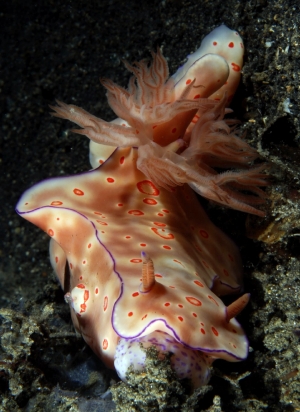
Dear Bill,
Here is another feeding shot for the forum. What is Ceratosoma feeding on?
Locality: Lembeh Strait, 30-65 Feet, Sulawesi, Indonesia, Celebes Sea, November 2006, Found on reef and sand. Length: 3/8 to 5 inches. Photographer: Bruce Wight .
Thanks
Bruce Wight
bruce.c.wight@boeing.com
Wight, B.C., 2007 (Jun 7) Ceratosoma trilobatum feeding. [Message in] Sea Slug Forum. Australian Museum, Sydney. Available from http://www.seaslugforum.net/find/19945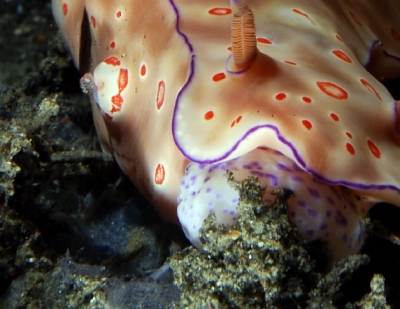
Dear Bruce,
Thanks for this photo of a brightly coloured Ceratosoma trilobatum. It is a good example of the difficulty in studying feeding in these animals as the sponge it is eating is partially covered by debris and silt, probably entangled in a mucus layer the sponge exudes. On the left foreground of your photo there are some purplish patches which I am pretty sure are the sponge colony it is eating. I think I can see some fibre structure which fits with Dysidea, the genus of sponges Ceratosoma trilobatum feeds on - but it could be wishful thinking on my part.
Best wishes,
Bill Rudman
Ceratosoma trilobatum from Indonesia
May 4, 2007
From: Natasja Vandeperre
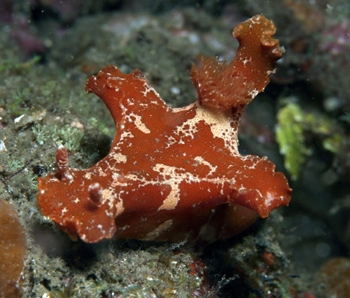
Hello Bill,
I got this picture of a lovely Ceratosoma sp. from Patrick Van Moer to put on my website. The only thing I know is that the picture was taken February 2006 in Lembeh.
Locality: Lembeh, 2 February 2006. Photographer: Patrick Van Moer.
Can you identify it?
Natasja Vandeperre
nvandeperre@pandora.be
Natasja, 2007 (May 4) Ceratosoma trilobatum from Indonesia. [Message in] Sea Slug Forum. Australian Museum, Sydney. Available from http://www.seaslugforum.net/find/19158Dear Natasja,
I am pretty sure this is Ceratosoma trilobatum.
Best wishes,
Bill Rudman
Re: Is Ceratosoma trilobatum a fakir?
October 31, 2006
From: Julia Socha
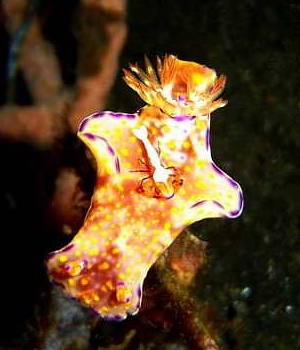
Concerning message #15556:
I personally think he is very busy guy! I can watch him almost every week during my muck dives in Lembeh. He has even his own cleaning service -check it out!
Locality: Lembeh strait, 7 metres, North Sulawesi, Indonesia. June 2006, MUCK. Length: 5cm. Photographer: Bernard Lamprecht.
Julia Socha
sochajulia@hotmail.com
Socha, J., 2006 (Oct 31) Re: Is Ceratosoma trilobatum a fakir?. [Message in] Sea Slug Forum. Australian Museum, Sydney. Available from http://www.seaslugforum.net/find/17797Thanks Julia,
It would be interesting to know whether the shrimps, like this Periclimenes - which are often found on large nudibranchs - have a cleaning role, or any other helpful role in the life of the nudibranch.
Best wishes,
Bill Rudman
Ceratosoma trilobatum in distress
July 28, 2006
From: Sean Kearney
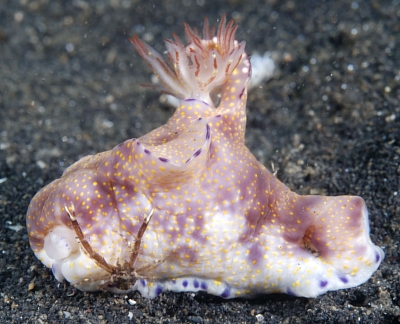
Dear Bill...
It was difficult to watch as this beautiful little slug was being attacked from all angles. It appears that the rhinophores are tucked in along with mouth parts for protection.
The two crabs kept circling over and around. I know that you like to get pics of slugs "doing things", thought I'd throw this in.
Locality: Police Pier, 45 feet, North Sulawesi, Indonesia, Lembeh Strait, 21 Feb 2006, Sand, mud. Length: 1 1/2 inch. Photographer: S. Kearney.
Sean Kearney
skearney@dc.rr.com
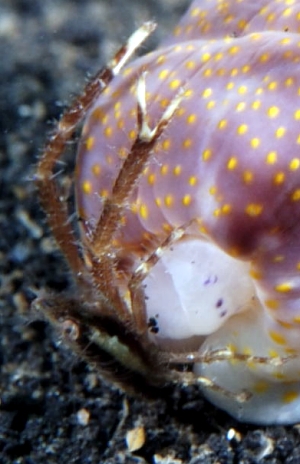
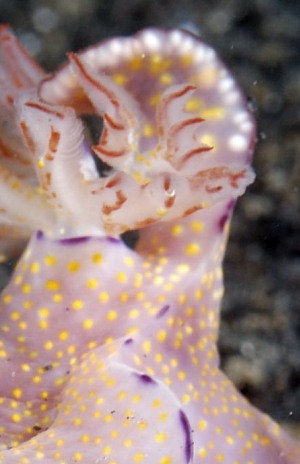
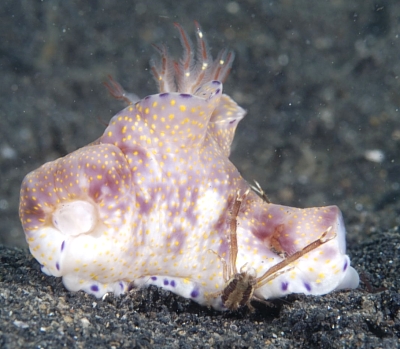
Thanks Sean,
It is a strange thing for these crustacea to attack - perhaps the Ceratosoma was already partially dead from some other misadventure? I think the crabs are anomuran squat lobsters [Fam. Galatheidae] rather than brachyuran 'true' crabs but I am open to correction. One interesting point I have illustrated in the middle right photo is the concentration of the defensive mantle glands on the dorsal horn [as opaque white spheres]. Usually they are not so obvious, so it appears they are swelling, perhaps in response to the pain of the attack.
Best wishes,
Bill Rudman
Re: Ceratosoma trilobatum from sthn Queensland
March 1, 2006
From: Ron Velarde
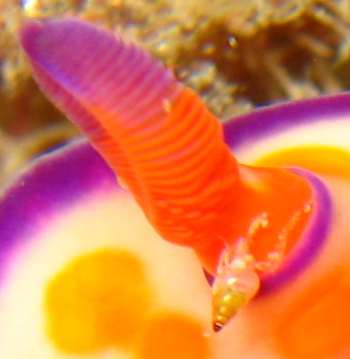
Concerning message #15930:
Hi Bill/ Bruce,
In the close-up photo, what do you think is near the right rhinophore? Looks like it could be a small gastropod of some kind; parasite? Or is it just debris?
Ron Velarde
rvelarde@sandiego.gov
Ron Velarde, 2006 (Mar 1) Re: Ceratosoma trilobatum from sthn Queensland. [Message in] Sea Slug Forum. Australian Museum, Sydney. Available from http://www.seaslugforum.net/find/15982Dear Ron,
Well spotted. I saw it there and decided it was irrelevant, but since you ask .... It is a small snail of some sort. I suspect it is an adult. There are thousands of small marine snails in mnay families. Some are parasites, some commensals, and some are free-living carnivores and algal grazers. They are often difficult to distinguish from their shell shape, but show a remarkable variability in anatomy. I suspect this snail got caught up in the nudibranchs mucous trail as it was crawling along. Apart from that I can't say anything sensible about it
Best wishes,
Bill Rudman
Ceratosoma trilobatum from sthn Queensland
February 27, 2006
From: Bruce Wilkie
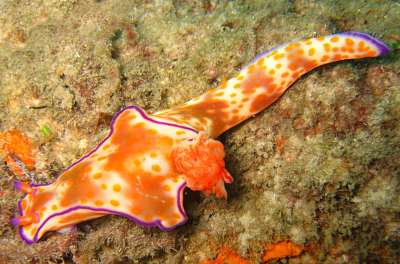
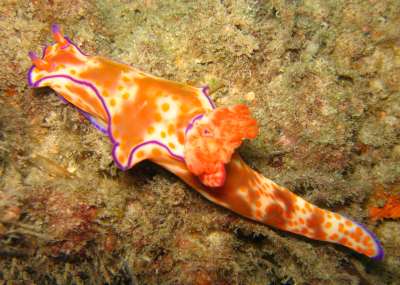
Hi Bill,
Here are some photos of Ceratosoma trilobatum for your records.
Locality: Amity Point, North Stradbroke Island, 7 metres, Queensland Australia, Moreton Bay, 15 February 2006, boat ramp sandy channel car bodies & junk. Length: 150 mm. Photographer: Bruce Wilkie.
Many thanks,
Bruce Wilkie.
brucedwilkie@yahoo.com.au
Wilkie,B, 2006 (Feb 27) Ceratosoma trilobatum from sthn Queensland. [Message in] Sea Slug Forum. Australian Museum, Sydney. Available from http://www.seaslugforum.net/find/15930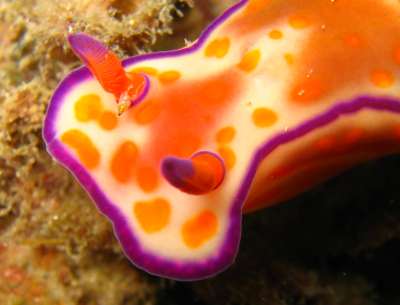
Thanks Bruce,
This is a particularly colourful example of the species. In the close up alongside you can see the small whitish mantle glands under the purple mantle margin at the front of the head. In this species the mantle glands are restricted mainly to this group at the front, and a large concentration in the tip of the recurved dorsal horn, behind the gills.
Best wishes,
Bill Rudman
Is Ceratosoma trilobatum a fakir?
January 16, 2006
From: Krystian Bala
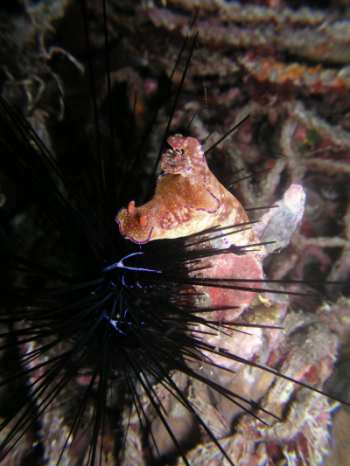
I'd like to know why this Ceratosoma trilobatum was doing this?
Was she just posing to attract my attention? :-)
Locality: Lembeh Strait, North Sulawesi,, Indonesia. Length: 8 cm. July 2005. Volcanic sand. Photographer: Krystian Bala
Best regards
Krystian Bala
amokdiver@gmail.com
Bala, K.S., 2006 (Jan 16) Is Ceratosoma trilobatum a fakir?. [Message in] Sea Slug Forum. Australian Museum, Sydney. Available from http://www.seaslugforum.net/find/15556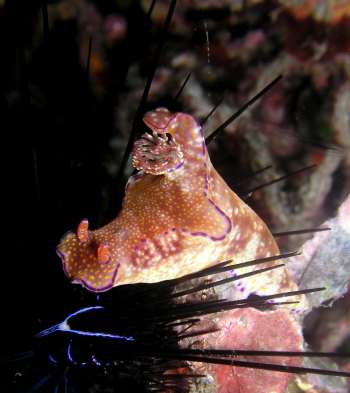
Dear Krystian,
I remember a politician here a few years ago when asked why he had done something particularly stupid just smiled and said "it seemed a good idea at the time".
Similarly, I don't think a nudibranch's brain has a department for forward planning.
Best wishes,
Bill Rudman
Ceratosoma from north end of Moreton Island
March 3, 2005
From: Gary Cobb
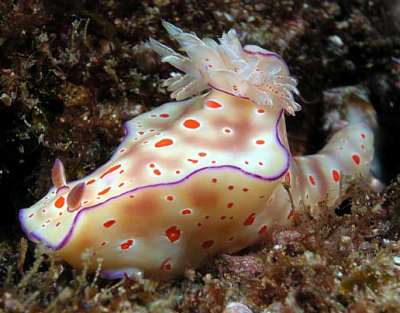
Hi Bill,
Here is an interesting animal I found while diving at a secret bit of reef known as Triple J. I have not seen this species of Ceratosoma before and thought I would share it with you and the viewers. Do you think it is C. trilobatum or C. tenue?
Locality: North Moreton Island, Queensland, Australia. Depth: 18 m. Length: 95 mm.13 November 2004. Outer reef. Photographer: Gary Cobb
Cheers
Gary Cobb
gary@nudibranch.com.au
Cobb G., 2005 (Mar 3) Ceratosoma from north end of Moreton Island. [Message in] Sea Slug Forum. Australian Museum, Sydney. Available from http://www.seaslugforum.net/find/13201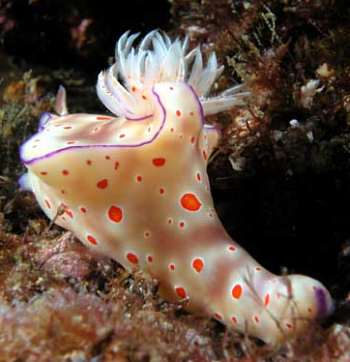
Dear Gary,
Species of Ceratosoma all seem to be quite variable in colour, but I must say this is a pretty spectacular example. Apart from the red spots, it fits C. trilobatum well.
Best wishes,
Bill Rudman
Ceratosoma trilobatum from Indonesia
February 18, 2004
From: Asther M. Lau
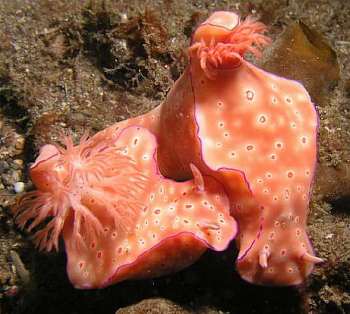
Hi Bill,
Please help confirm if this one is a Ceratosoma trilobatum .
It was found by my friend (Sim Chee Ghee) at a trip to Manado Island, North of Sulawesi in Indonesia last April 2003. Seems like this pair is getting ready to mate.
I have no further information of the dive as he has lost his log book containing this dive profile where he found this pair.
Hope you can help.
Thank you,
Asther M. Lau
alau425@hotmail.com
Lau, A.M., 2004 (Feb 18) Ceratosoma trilobatum from Indonesia. [Message in] Sea Slug Forum. Australian Museum, Sydney. Available from http://www.seaslugforum.net/find/12216Dear Asther,
Yes this is a colour form of Ceratosoma trilobatum.
Best wishes
Bill Rudman
Ceratosoma trilobatum from Japan
November 25, 2003
From: Jason Bell
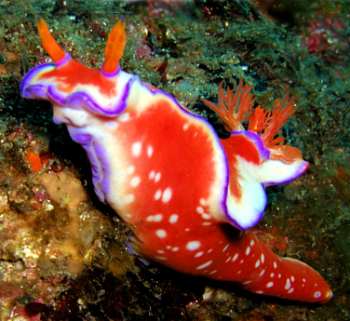
Bill,
I observed this Ceratosoma trilobatum at about 12m, Nov. 16, 2003, Hatsushima Island, Japan.
I took several pictures of the animal and started to change positions for different angle. Ceratosoma trilobatum stopped and reared up givening me chance to shoot the second picture. I have no idea why reared up, but third shoot is side view.
Jason
belljason@hotmail.com
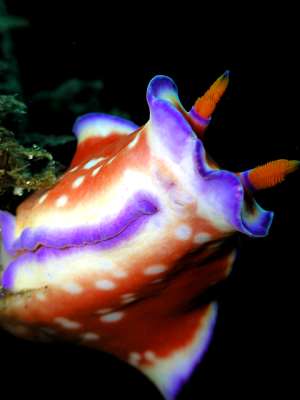
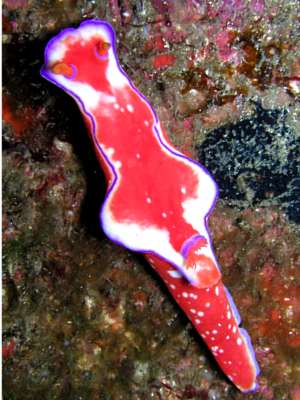
Thanks Jason,
"Rearing up' like this is a fairly typical way for me nudibranchs to sense things in the water - much like a dog will raise its nose and sniff around on a windy day.
This is an interesting colour form similar to one which Baba (1949: Pl. 20 fig 74) described from Japan as a new species Ceratosoma bicolor. In that animal the red on the mantle was reduced to a broad median line running from the head to the gills. Interestingly, Baba illustrated another animal on the same page [Pl 20, fig 72] which is almost identical to your photo, except it at more white spots on the mantle than yours. he identified that as a colour form of Ceratosoma cornigerum, which is a synonym of C. trilobatum.
• Baba, K (1949) Opisthobranchia of Sagami Bay collected by His Majesty The Emperor of Japan. Iwanami Shoten, Tokyo. 194pp., 50 Pls.
Best wishes
Bill Rudman
Ceratosoma trilobatum from Philippines
September 16, 2003
From: Vasa P. Sirinupongs
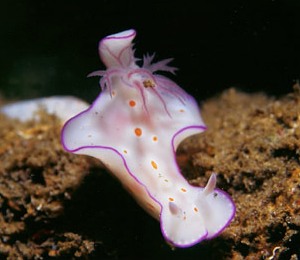
Hello Bill,
I cannot find a name of this nudi. I am sending it to you for your help.
Site: Dumaguete, Philippines
Length: 2 inches
Depth: 15m
Date: May 2003
Many thanks.
Vasa P. Sirinupongs
photo@scubadiving.com
Sirinupongs, V.P., 2003 (Sep 16) Ceratosoma trilobatum from Philippines. [Message in] Sea Slug Forum. Australian Museum, Sydney. Available from http://www.seaslugforum.net/find/10339Dear Vasa,
This is a colour form of Ceratosoma trilobatum.
Best wishes,
Bill Rudman
Ceratosoma trilobatum from Oman
September 2, 2003
From: Luigi Montevecchi
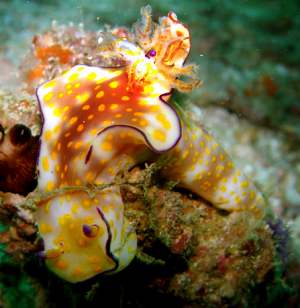
Hello, Bill.
This is a picture of a Ceratosoma trilobatum found at Lima Rock, Musandam Peninsula, Oman, on August 13, 2003, about 20 mt depth.
It was about 6-7 cm. long, standing on a rocky and sandy bottom. The water temperature about 26°C
Best Regards
Luigi Montevecchi,
Roma (Italy)
montevecchi@iol.it
Montevecchi, L., 2003 (Sep 2) Ceratosoma trilobatum from Oman. [Message in] Sea Slug Forum. Australian Museum, Sydney. Available from http://www.seaslugforum.net/find/10854Thanks Luigi,
Bill Rudman
Ceratosoma trilobatum from Taiwan
June 23, 2003
From: Todd Garthwaite
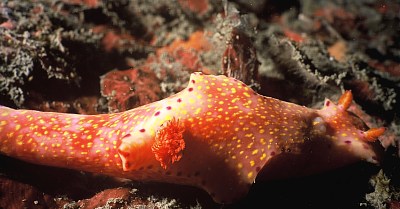
Hi Bill,
Here’s a shot of a Ceratosoma trilobatum
Same shallow, silty area of BaDouZi, as where I came across the pair of Glossodoris atromarginata.
Site: BaDouZi, (N.E. Coast, Taipei County, Taiwan), 24 May 2003, 11:00am. Depth: 12 meters. Water temp.: 24 deg. Celsius. Size: Very large / approximately 70+ mm.
Stay golden.
Peace, love, & nudis
Todd Garthwaite
typhoontoddy@yahoo.com
Garthwaite, T., 2003 (Jun 23) Ceratosoma trilobatum from Taiwan. [Message in] Sea Slug Forum. Australian Museum, Sydney. Available from http://www.seaslugforum.net/find/10217Thanks Todd,
Bill Rudman
Ceratosoma trilobatum? from the Philippines
May 20, 2003
From: Erwin Köhler
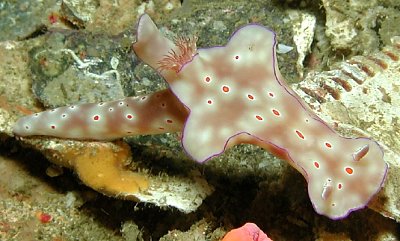
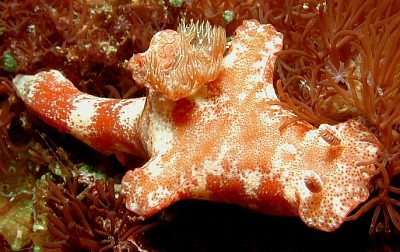
Dear Bill,
Is the top animal Ceratosoma trilobatum?
Data -
Size: 72mm
Depth: 20m
Date: Feb. 24, 2003
Location: Philippines, Malapascua Island, "Gato Corner"
I have attached a photo of the normal colour form also - same data, size 85mm [Lower Photo]
Erwin
Erwin@medslugs.de
Köhler, E., 2003 (May 20) Ceratosoma trilobatum? from the Philippines. [Message in] Sea Slug Forum. Australian Museum, Sydney. Available from http://www.seaslugforum.net/find/9756Dear Erwin,
The short answer is yes. When I looked at this genus some years ago the only external differences I could match with anatomical differences were in body shape. I know in most chromodorids that colour is a very good indicator of species, but it doesn't seem to be so in Ceratosoma. We could of course be wrong.
Best wishes,
Bill Rudman.
Ceratosoma trilobatum from Eilat
April 2, 2003
From: Michael Levin
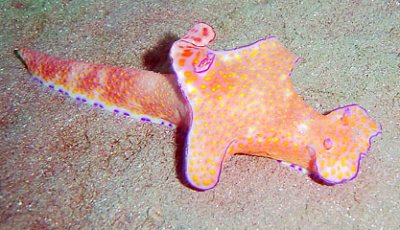
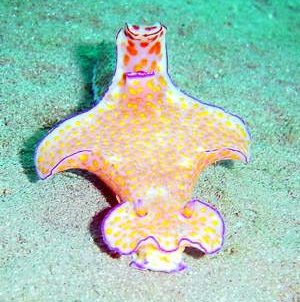
Hello Bill,
I enjoy to visit your wonderful web site, keep on with the good job.
I hope you would be interested in these photos of Ceratosoma tenue Something interesting about this nudibranch is that it moves very fast on the sandy bottom and it quite huge (about 15cm).
Locality: North beach of Eilat, northen part of Gulf of Eilat (Aqaba), Red Sea.
Depth: 15m
Date: Feb 2003
Size: 150mm
Michael Levin
michael@scubadiving.com
Levin, M., 2003 (Apr 2) Ceratosoma trilobatum from Eilat. [Message in] Sea Slug Forum. Australian Museum, Sydney. Available from http://www.seaslugforum.net/find/9507Dear Michael,
Thanks for these photos of Ceratosoma trilobatum. C. tenue tends to be more elongate and has a secondary lobe on each side between the head and the gills. This is quite an interesting colour form in which the dorsal 'horn' with its red spots is quite a different colour to the rest of the body.
Most species of Ceratosoma have a long recurved dorsal 'horn' which acts as a defensive lure attracting potential predators to the part of the animal which contains most of the distasteful chemicals stored from their food. See Ceratosoma brevicaudatum for photos of its conspicuously marked 'tail', especially in juveniles. This colour 'target' probably also attracts potential predators to the most distasteful part of the animal (Rudman, 1991). See photo of Ceratosoma tenue from Dar es Salaam, in which whole dorsal horn has been cut off, probably bitten off.
• Rudman, W.B. (1991) Purpose in Pattern: The evolution of colour in chromodorid nudibranchs. Journal of Molluscan Studies, 57 (T.E.Thompson Memorial Issue): 5-21.
Best wishes,
Bill Rudman
Ceratosoma with Emperor shrimp at Lembeh St
January 4, 2003
From: Danny Van Belle
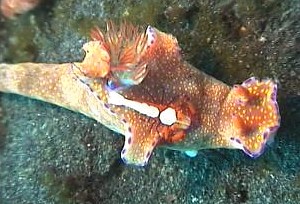
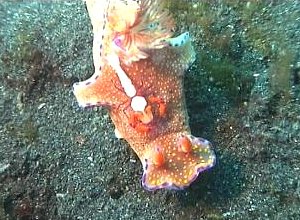
Hi Bill,
Some nice pictures of Ceratosoma with emperor shrimp. Can you tell me which Ceratosoma exactly ?
Filmed at Lembeh Strait, Northern Sulawesi,
Indonesia, 3m depth, 22 April, 2002
Thanks,
Danny
dannyvb@hotmail.com
Van Belle, D., 2003 (Jan 4) Ceratosoma with Emperor shrimp at Lembeh St. [Message in] Sea Slug Forum. Australian Museum, Sydney. Available from http://www.seaslugforum.net/find/8572Dear Danny,
This is Ceratosoma trilobatum.
Best wishes,
Bill Rudman
Ceratosoma from Thailand
December 23, 2002
From: Danny Van Belle
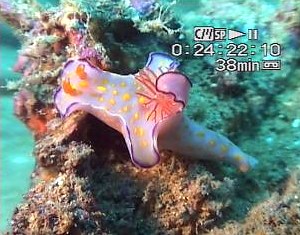
Hi again,
Here a nice Ceratosoma from Thailand.
Location: Boonsung wreck - Taplamu - Andaman Sea. Depth: 20m, Date: 10 January 2002
Which one is this exactly?
Danny
dannyvb@hotmail.com
Van Belle, D., 2002 (Dec 23) Ceratosoma from Thailand. [Message in] Sea Slug Forum. Australian Museum, Sydney. Available from http://www.seaslugforum.net/find/8568Dear Danny,
This is Ceratosoma trilobata. From the proportionally large yellow spots I suspect this is a juvenile.
Best wishes,
Bill Rudman
Ceratosoma trilobatum from Riau, Indonesia
November 12, 2002
From: Alice Lee
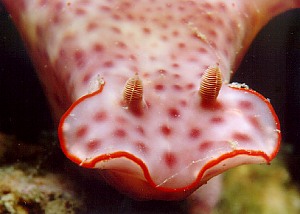
This is an extreme close-up of Ceratosoma trilobatum, I'm was using my 2:1 framer when I took this photo.
Riau Archipelago, Indonesia
Depth: 10m
Size: 3 inch
Date: 27/10/02
Regards,
Alice
alee@dlink.com.sg
Lee, A., 2002 (Nov 12) Ceratosoma trilobatum from Riau, Indonesia. [Message in] Sea Slug Forum. Australian Museum, Sydney. Available from http://www.seaslugforum.net/find/8328Thanks Alice,
Bill Rudman
Ceratasoma trilobatum with shrimp
October 12, 2002
From: Marli Wakeling
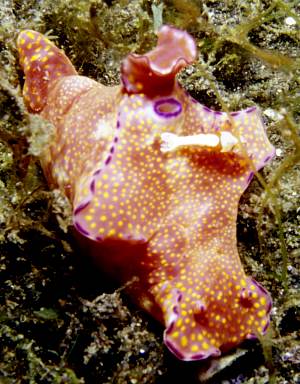
Hi Bill,
Here is what I think is Ceratosoma trilobatum with a hitchiker Periclimenes imperator on board. We always saw these and Ceratasoma tenue on night dives at this site.
Location: Jahir, Lembeh Straight, Sulawesi, Indonesia
Date: July 2002
Depth: 35 feet
Length: 10cm.
Photographs: Marli Wakeling
Marli
scubamarli@excite.com
Wakeling, M., 2002 (Oct 12) Ceratasoma trilobatum with shrimp. [Message in] Sea Slug Forum. Australian Museum, Sydney. Available from http://www.seaslugforum.net/find/8126Thanks Marli,
This shrimp seems to be happy on quite a range of large opisthobranchs
Best wishes,
Bill Rudman
Ceratosoma trilobatum from Taiwan
July 23, 2002
From: Todd Garthwaite
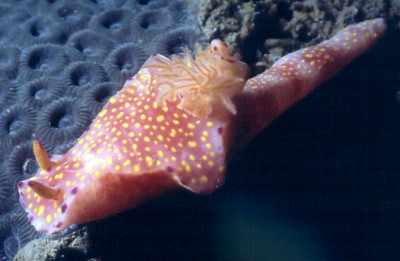
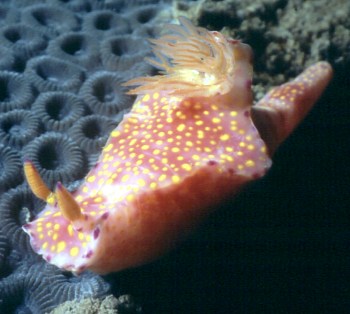
Hi Bill,
Here are several shots of a Ceratosoma trilobatum (perhaps?), which I came across in a 'drop-off' area strewn with boulders, lots of silt, and small patches of soft and hard coral.
Site: KM Marker #92, (N.E. Coast, Taipei County, Taiwan), 30 June 2002, 09:34am
Depth: 20.1 meters. Size: approximately 65 mm
Stay golden.
Peace, love, & nudis
Todd Garthwaite
typhoontoddy@yahoo.com
Garthwaite, T., 2002 (Jul 23) Ceratosoma trilobatum from Taiwan. [Message in] Sea Slug Forum. Australian Museum, Sydney. Available from http://www.seaslugforum.net/find/7565Thanks Todd,
Yes this is C. trilobatum
Best wishes,
Bill Rudman
Ceratosoma sp.? from Queensland
June 3, 2002
From: Greg Carter
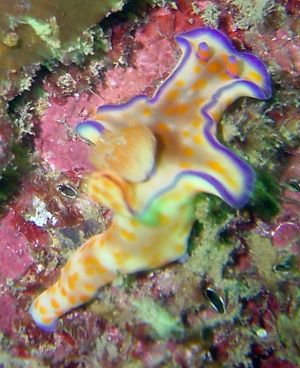
Dear Dr Rudman,
I was on a dive recently at the Tangalooma Wrecks on Moreton Island, southern Queensland, Australia. At about 7/8 metres I came across what I think is a Ceratosoma of some type. I have looked through your species list but I'm not able to ID it at all. Any ideas would be appreciated.
Regards.
Greg Carter
greg.carter@epa.qld.gov.au
Carter, G., 2002 (Jun 3) Ceratosoma sp.? from Queensland. [Message in] Sea Slug Forum. Australian Museum, Sydney. Available from http://www.seaslugforum.net/find/7108Dear Greg,
This is Ceratosoma trilobatum. For some reason it seems to have some quite spectacular colour forms at the subtropical extremes of its geographical range. There are a number of species of Ceratosoma with the same, or similar, variations in colour pattern. The best external distinguishing character for C. trilobatum is the edge of the mantle, which in this species forms an unbroken ridge around the mantle with one lateral extension on each side just anterior to the gill pocket. These two lobes, plus the posterior dorsal horn, behind the gills, give it the name 'trilobatum' or 'three lobes'.
Best wishes,
Bill Rudman
Ceratosoma trilobatum from Riau Archipelago
April 1, 2002
From: Alice Lee
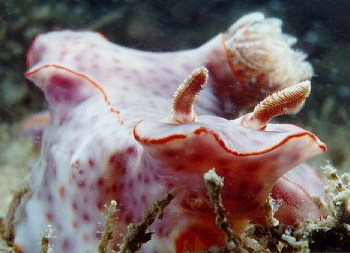
Hi, Bill,
This huge nudibranch is also taken in Riau Archipelago, [Indonesia, just south of Singapore] I think it's Ceratosoma trilobatum. The size is about 5 inches [approx 12cm], taken in the depth of 10m.
Alice
alee@dlink.com.sg
Lee, A., 2002 (Apr 1) Ceratosoma trilobatum from Riau Archipelago. [Message in] Sea Slug Forum. Australian Museum, Sydney. Available from http://www.seaslugforum.net/find/6559Thanks Alice.
Yes this is C. trilobatum which is quite variable in colour.
Bill Rudman
Ceratosoma trilobatum from Red Sea
July 13, 2000
From: Jochen Scholtyssek
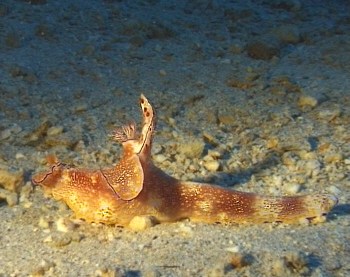
Dear Bill,
Here are some more Fotos, what is I.D.?
Red Sea, Akaba, Jordan,
November 1999,
Depth 20 meters.
Inside Wreck 'Cedar Price'.
Best wishes
Jochen
joscholty@t-online.de
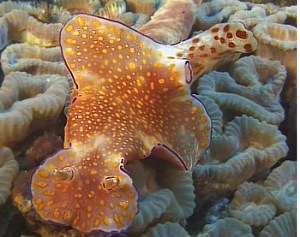
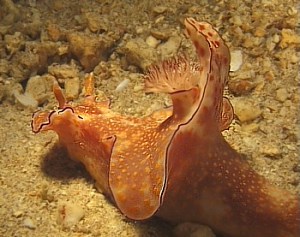
Dear Jochen,
This is Ceratosoma trilobatum. It is a chromodorid, related to the Chromodoris and Hypselodoris you sent earlier, even though it doesn't look much like them. The spectacular dorsal horn, just behind the gills, which features in all your photos, is a characteristic of many species of Ceratosoma.
This dorsal horn contains a gland filled with distasteful chemicals the slug has obtained from its sponge food. I think this horn is used as a 'lure' - something fish will be tempted to bite. If they do bite it they will get a mouthful of distasteful secretions which should deter them from having a bite at some more important part of the body. If you have a look at the top of the page you will see I talk about the dorsal horn and suggest some other pages to look at.
Best wishes,
Bill Rudman.
Ceratosoma trilobatum from Thailand
April 23, 2000
From: Narongpon Sittithaweepat

Dear Bill
I am not sure if this specimen is Ceratosoma tenue. I found it at Similan Island. The photo is by Dr. Thon Thamrongnawasawat. It is found all over Thailand. So could you identify it for me, please.
Thank you,
Narongpon
chromodorid@thaimail.com
Sittithaweepat, N., 2000 (Apr 23) Ceratosoma trilobatum from Thailand. [Message in] Sea Slug Forum. Australian Museum, Sydney. Available from http://www.seaslugforum.net/find/2213Dear Narongpon,
Your photo is of Ceratosoma trilobatum. Ceratosoma trilobatum and Ceratosoma tenue have caused some confusion in the past because they have a similar range of colour variation. One simple external difference is the number of mantle lobes. 'trilobatum' means 'three lobes' and that species has one large lobe on each side [= 2 lobes] and the large posterior recurved horn behind the gills [total = 3 lobes].
Ceratosoma tenue differs in having a second smaller lobe on each side of the mantle between the head and the gills [a total of 5 lobes].
Best wishes,
Bill Rudman.
Ceratosoma trilobatum from sthn Queensland
September 30, 1999
From: Tim Murrell
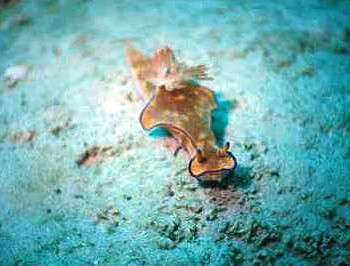
Dear Dr Rudman,
I have been interested (as a hobby) in molluscs for about 16 years. Recently I bought an underwater camera and have been happily snapping photos of everything whilst diving and then adding them to my data base.
I have been looking at the Slug Forum recently to try and identify a couple of pictures. Whilst there I was looking for information about Ceratosoma trilobatum (of which I have attached a photo), in particular the author and date. Would you be able to supply me with this information as it isn't in the Forum.
The photo was taken in 22m on the Curtain Artificial Reef just off Moreton Island, Moreton Bay, southeastern Queensland. The animal was about 100mm in length.
Thanks
Tim Murrell
timm@powerup.com.au
Murrell, T., 1999 (Sep 30) Ceratosoma trilobatum from sthn Queensland. [Message in] Sea Slug Forum. Australian Museum, Sydney. Available from http://www.seaslugforum.net/find/1382Dear Tim,
It was only a matter of time before I was forced to prepare a page on Ceratosoma trilobatum. Your question was the catalyst, so the information you want is at the top of this page. I have also prepared a page on the similarly coloured species Ceratosoma tenue.
The photo you sent is of an interesting colour form with a continuous purple border and large orange spots, which is quite common in southern Queensland.
I look forward to seeing some more of your 'happy snaps'
Best wishes,
Bill Rudman.
Ceratosoma trilobatum & C. tenue
September 30, 1999
From: Bill Rudman
To answer Tim Murrell's question on Ceratosoma trilobatum, I have prepared pages on Ceratosoma trilobatum and Ceratosoma tenue.
Bill Rudman.
